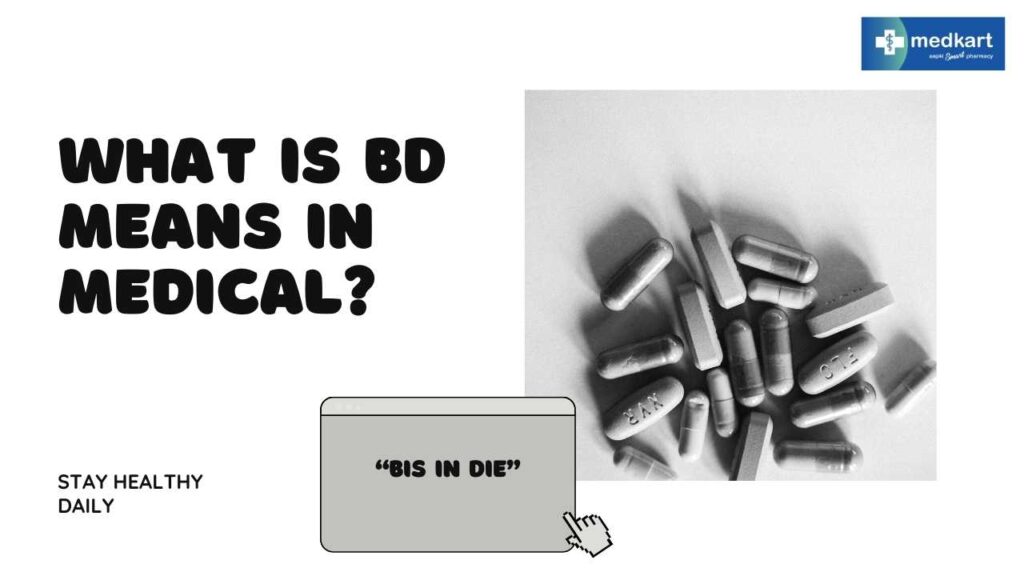Last updated on April 16th, 2025 at 04:16 pm

BD meaning in Medical – The intricate language of medicine, where precision and clarity are crucial, relies heavily on abbreviations and acronyms to efficiently communicate essential information. Among these, the abbreviation BD holds a significant place, providing succinct direction regarding dosing regimens, treatment schedules, and therapeutic guidelines.
BD Full Form in Medical
The BD full form originates from the Latin phrase “bis in die,” which translates to “twice a day” in English. Doctors use this abbreviation to tell patients how often to take medication or receive treatment. This helps ensure patients get the right care.
When a healthcare professional prescribes a medication and designates it as “take 1 tablet BD,” the directive signifies that the patient must ingest one tablet of the prescribed medicine two times a day, ideally spaced approximately 12 hours apart. The objective behind using such an abbreviation is to furnish clear and concise instructions that can be readily comprehended by both medical practitioners and patients, ensuring the medication’s intended therapeutic impact is achieved.
BD Means in Medical
While BD means in medical terms has historically been a widely recognized abbreviation, its usage has garnered increased scrutiny in recent years. Therefore, concerns have arisen regarding the potential for misinterpretation or confusion by patients or healthcare providers. The risk of errors stemming from ambiguous abbreviations has prompted a reevaluation of medical communication practices.
Healthcare professionals should strive to provide clearer instructions in order to bolster patient safety.

BD meaning in Medical Prescription
The movement to diminish the reliance on abbreviations like BD aligns with broader efforts in healthcare to prioritize patient well-being and mitigate avoidable risks. Additionally, miscommunication related to dosing frequencies could result in incorrect medication administration, jeopardizing treatment outcomes or, in extreme cases, compromising patient health. By embracing clearer communication strategies, medical practitioners aim to reduce the margin for error and ensure that patients receive the appropriate care they require.
Furthermore, the advent of modern technology and electronic health records has introduced new avenues for refining medical communication. Electronic prescribing systems often include built-in safeguards that flag potentially ambiguous or risky abbreviations, adding an additional layer of safety to the prescription process.
This advancement underscores the medical community’s dedication to optimizing patient care through the integration of technology and evidence-based practices.
Read: What are Generic Medicines?
Conclusion
BD in medical terms stands as an abbreviation for “bis in die,” indicating “twice a day.” Rooted in Latin, this abbreviation is utilized to signify the frequency at which medications or treatments should be administered. While historically prevalent, concerns about potential misinterpretations have spurred a shift towards more explicit instructions in medical communication.
The objective is to foster patient safety, enhance treatment effectiveness, and minimize the potential for dosing errors. As medicine continues to evolve, the emphasis on precise and unambiguous communication remains a cornerstone of high-quality healthcare delivery.
> Consult a Doctor and Medkart will help you Order Medicines Online
FAQs on BD Means in Medical
Q1. What does BD stand for in medical terms?
BD meaning in Medical stands for “bis in die,” a Latin term that translates to “twice a day” in English. In medical contexts, practitioners commonly prescribe taking or administering a medication or treatment two times a day, with an approximate interval of 12 hours between doses.
Q2. How is BD used in medical prescriptions?
Medical prescriptions include BD to specify the dosing frequency of a medication. For instance, if a doctor prescribes a medication with the instruction “take 1 tablet BD,” it means that the patient should take one tablet of the medication twice a day, typically in the morning and evening.
Q3. Why is there a movement to reduce the use of BD and similar abbreviations in medical communication?
There has been a push within the medical community to minimize the use of ambiguous abbreviations like BD to prevent medication errors and improve patient safety. Misinterpreting these abbreviations can lead to incorrect dosing and potentially harmful consequences. As a result, healthcare providers are encouraged to use more explicit instructions, such as specifying the actual times for medication administration, to ensure accurate understanding and safer patient care.
Related Links:
